Summer fresh tomatoes are packed into jars and canned with fresh garlic and red onions. Well-seasoned and preserved Canned Tomato Bruschetta can be easily and quickly assembled at any time! Pile onto grilled bread or toss with cooked pasta for a delicious meal! This is a great way to preserve your homegrown tomatoes!
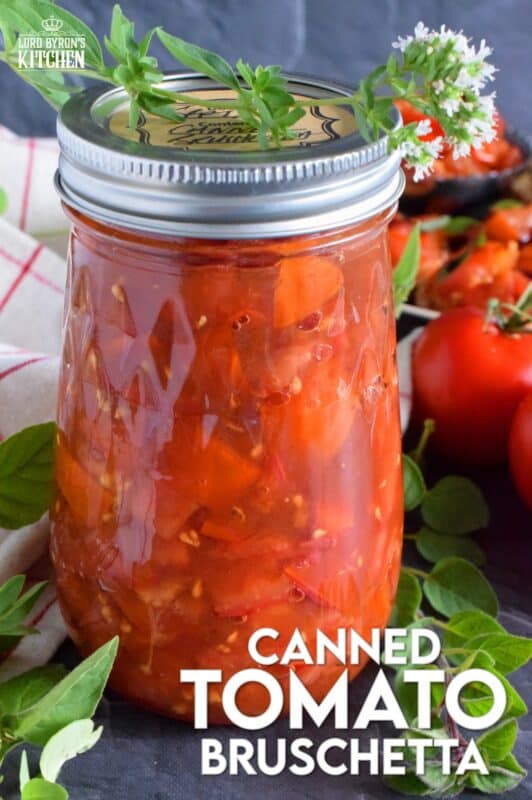
Last summer, I was craving bruschetta all the time. It’s not a weird craving for me. In fact, I often crave grilled or toasted bread that has been topped with tomatoes. That’s probably why I make Toasted Tomato Sandwiches so often! Most often, the tomato mixture used for bruschetta is eaten right away. But, I thought it would be possible to can it and preserve all of that summer fresh tomato flavour, so I tried it. Canned Tomato Bruschetta is so easy and oh, so delicious!
I really do think that marinating the tomatoes with the onions and garlic makes for a better-tasting bruschetta. During the canning process, excess air is removed from the jar to prevent spoilage, but I can’t think of a better way to get all of those flavours combined!
Make your own online recipe box!
Click the in the lower right corner of your screen
& follow the quick and easy instructions!
SUMMER FRESH TOMATOES
If you’re thinking about making bruschetta at all, you must have some summer fresh tomatoes on hand, right? The whole concept of bruschetta is about combining freshly chopped tomatoes with a few basic ingredients. Obviously, I have taken some liberties by creating a canning recipe with them. For example, I used white vinegar instead of balsamic. When you open the jar and you’re ready to dig in, drizzle the top with balsamic.
Any tomato will do, but I think the best tomatoes are the ones with more meatiness. When a tomato is described as being meatier, it simply means that the ratio of tomato flesh to the seeds and pulp mixture is higher. A good example of this is the beefsteak tomato. They are quite large and the walls of the tomato are thick and sturdy. They’re most often found on sandwiches for this reason.
For me, personally, I prefer the roma tomato. In my opinion, this variety has the best flavour, and most certainly, the best colour. A perfectly ripe roma tomato has a deep red colour and just pops in contrast to other recipe ingredients. I use the roma tomato almost exclusively in my recipes. Tomatoes on the vine are perfect for this recipe too!

WHAT IS BRUSCHETTA?
Unlike this Canned Tomato Bruschetta, bruschetta itself has a long history. Some say it dates back to the Ancient Romans. One this is certain, and that is for centuries it has fed labourers and farmers with day-old bread. It served both as a hearty snack or meal for those doing hard manual labour and as a way to salvage bread that had gone stale.
The beauty of bruschetta is its simplicity. There is no way to make a good bruschetta from bad ingredients. It has to be fresh; it has to have the best ingredients available. Otherwise, it’s edible, yes, but it’s just mediocre at best. Locally-grown tomatoes are a must! Use good-tasting olive oil. Does it need to be expensive? No. It just has to taste good to you. Pour olive oil onto your finger. Taste it; is it good? Great! If not, try another brand.
I found this description online and it sums up bruschetta perfectly. It’s an Italian appetizer consisting of grilled bread rubbed with garlic and topped with olive oil and salt. It is often topped with tomato, vegetables, beans, cured meat, or cheese. The most popular is bruschetta with tomatoes, fresh basil, garlic, onion, and seasonings.

INGREDIENTS NEEDED FOR THIS RECIPE
The following is a list of the ingredients needed to prepare this recipe. For exact amounts and measurements, refer to the printable recipe card located near the bottom of this post.
- Garlic – Freshly minced garlic here! None of that jarred or tube type!
- Tomatoes – Meaty tomatoes are best. I used roma tomatoes.
- Red Onion – You can put in as much red onion as you wish, but it is strong. I used one small red onion.
- White Vinegar – Bruschetta is made with balsamic vinegar, but I wouldn’t attempt canning entirely with it, because one whole cup of balsamic, which is the amount of vinegar needed for this recipe, will be very strong!
- Water
- Sugar – Not normally present in bruschetta, the sugar in this case helps to keep the tomatoes sweet and fresh. Plus, sugar is a preservative!
- Dried Basil and Oregano
HOW TO MAKE CANNED TOMATO BRUSCHETTA
Add the garlic, vinegar, water, sugar, basil, and oregano to a large saucepan. Over medium heat, bring to a boil. Once boiling, lower the heat to low and simmer for 5 minutes.
In the meantime, pack the chopped tomatoes into clean mason jars. Once the vinegar mixture has simmered for 5 minutes, ladle it into the jars, covering the tomatoes. Remove any air bubbles and top up the brine, leaving 3/4 of an inch of headspace.
Place a lid on the jar and waterbath can the jars for 10 minutes. Remove the jars from the canner and allow them to fully cool on a wire cooling rack covered with a clean tea towel for 24 hours. Once cooled, wash and dry the jars. Label and store in a dark, cool pantry.

HOW TO WATER BATH CAN
STEP 1: PREPARING THE JARS
Some canners say that if you need to boil the jars longer than 10 minutes, then you don’t need to sterilize the jars. I say no! Canning is not as simple and cheap as frying an egg. It takes time, and an investment if you don’t already have the equipment. Eliminate any risk whatsoever by always sterilizing your jars. It’s easy to do and your Canned Tomato Bruschetta will thank you! Wash the jars in hot, soapy water. Rinse the jars well under running water to get rid of any soap residue.
Transfer the jars to a large pot of water. Bring to a boil and boil for 2-3 minutes. Using a jar wrench/lifter, lift the jars out of the water, tilting to pour out the water. Be careful; it’s hot! Stand the jar up on a baking sheet. Once all of the jars are on the baking sheet, place them into your preheated oven at 200 degrees F. This will keep them hot and away from any contamination.
STEP 2: PREPARING THE SEALS AND RINGS
Mason jars are equipped with three parts. The first is the jar. The second and third parts combine to form the lid. The flat disc with the rubber ring on the bottom is the seal. Finally, the circular part that actually screws onto the jar is called a screw band. Depending on the brand or the recipe you’re reading, the names of these things can vary. But, they all do the same thing.
The screw bands never come in contact with the food, so they do not need to be washed or sterilized. But, because I want to eliminate any risk of contamination, I make sure they’re clean. After all, they have been sitting in a warehouse before they got to the store, and then finally, to me. That’s too many germs for my comfort level! I wash them in hot, soapy water, rinse them well, and transfer them to a bowl until I need them. The sealing disk/sealing ring needs a little more consideration.
If you look at the bottom of the lid, you will see a reddish-brown rubber ring. It’s attached to the lid. This ring has a huge job! It is pretty much in charge of keeping your food safe for long-term storage. Place the lids into a glass bowl. I like to separate them so that they are not all stacked. When I’m ready to ladle the food into the jars, I pour a kettle of boiling water over the lids so that they are sterile and the rubber band softens. That’s it. You have now prepared your jars. Next, we need to get the canner ready!
STEP 3: PREPARING THE CANNER
You can buy a canning pot, but you don’t have to do that. Any stock pot will do just fine. Be sure that the pot is tall enough to hold enough water so that your jars are covered by at least an inch of water. Fill the canning pot accordingly. Also, be sure to insert a canning rack or mat into the bottom of your pot. If you buy a canning pot it will come with one. Otherwise, you can buy them for any pot size. Never let your jars touch the bottom of the pot when boiling. They could easily break and your Canned Tomato Bruschetta will be lost. Once you’ve done this, bring the water to a full boil.
In most cases, if you’re new to canning, you might notice some white residue on the jars after all is said and done. This can easily be cleaned off once the jars are cool. A few tablespoons of white vinegar in the boiling water helps to eliminate most of it. I use it every single time.
Lastly, it’s always a good idea to keep a kettle of boiling water close by. Depending on how many jars you need to process, you might have to boil them in batches. You will be surprised at how quickly rapidly boiling water can evaporate. Having a kettle of boiling water will allow you to easily top up the canning pot without altering the temperature of the water.
STEP 4: FILLING THE JARS
Depending on the recipe, filling the jars is quite easy. Having some inexpensive equipment on hand can make this process much easier. Invest in a canning funnel. It will help you ladle the food into the jars without making a mess. Remember to pay attention to the recipe’s recommended headspace. This is the amount of empty space from the top of the food to the very top of the jar. Also, it’s imperative to keep the rim of the jar clean to ensure a good seal. You will also need a bubble remover. You can buy these, but I’m not a fan of them. A clean wooden chopstick does the same thing. Removing bubbles will prevent mould from growing.
Lastly, you will need a magnetic lid lifter. Remember how I said the flat sealing lids will be submerged in a bowl of boiling water? Well, you can’t just pick them up with your hands. First of all, it’s hot! Secondly, you will want to eliminate the risk of any contamination. Do not touch the underside of the lid. Period! Using a magnetic lid lifter will allow you to pick up the lid and position it right onto the rim of the jar without ever touching it.
Finally, you will need to screw on the metal screw bands. In most cases, the food in the jars is scalding hot, so you can’t touch the jars to tighten the lids. But, that’s a good thing! You should never over-tighten the lids. Place the screw band over the jar and tighten it with one hand. It should be snug, not tight. Now, that’s it! You’re ready to boil these jars!
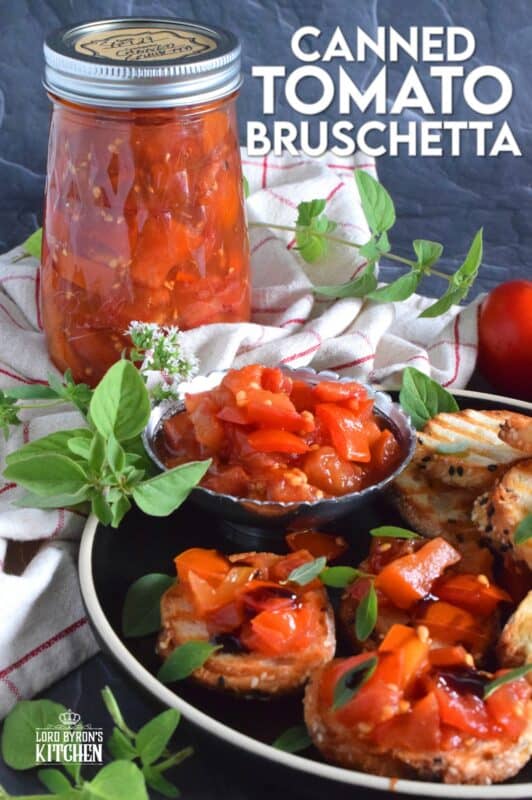
STEP 5: BOILING THE JARS OF FOOD
Carefully lift the jars of Canned Tomato Bruschetta straight up using a jar wrench/lifter. Lower the jar into the pot of boiling water. Fill the canning pot with jars in this manner. Don’t jam the jars in; leave a little bit of space between the jars. I aim for about a centimetre or a finger’s width. Remember, you can process the jars in batches.
Once the canning pot is loaded, place a lid on the pot, and start your timer according to the recipe you are following. If the water is not at a full boil, do not start timing until it is! When the time is up, use the jar wrench to lift the jars straight up out of the water. Transfer the jars to a flat surface that has been lined with a few layers of kitchen towels. Allow the jars to fully cool – at least 24 hours! Finally, wipe the jars down, label them with contents and date, and store them in a cool, dark cupboard or pantry.
Some people remove the screw bands after the jars have cooled for 24 hours. I remove them just to check if there is a good seal. I put them back on once I’ve checked. It’s up to you if you want to leave them off. If you notice that a jar has not been sealed, you can either discard it or refrigerate it for immediate consumption. Only do so if you are 100% sure the food has not been compromised and that it is safe to eat.
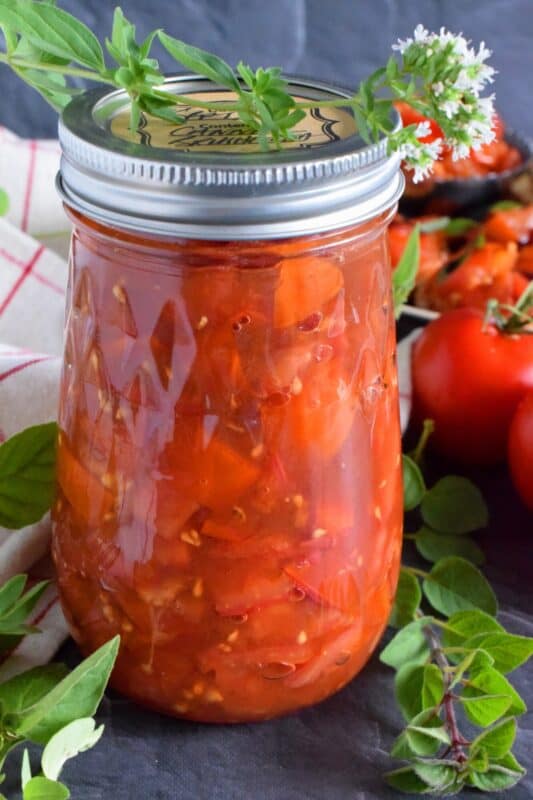
STORING CANNED TOMATO BRUSCHETTA
Once you have safely removed the jars of processed Canned Tomato Bruschetta from the canner, and they have cooled completely, it’s time to store them.
Storing properly is just as important as every step you take to ensure your efforts are safe and sterile. The first thing I like to do is wash the jars. Sometimes, the jars will be covered with a residue from the boiling process. This is normal and will depend on your water source. If I can in our city apartment, the jars are not too cloudy at all. But, at our home in the country where we use well water, the jars will have a chalky, white residue on the outside.
You can wash the jars under warm running water with a little bit of dish detergent. Dry the jars well with a clean towel. Next, it’s important to label them properly. Trust me – if you fall in love with canning, you’ll come to rely on labels. In the beginning, I could easily mistake a jar of canned tomatoes for a jar of salsa or a jar of sauce!
Your label should include the name of the recipe and the date you made it. Store the jars in a cool, dark place. You don’t need to push them all to the back of the corner in your unfinished basement! Any pantry or cabinet will do as long as it’s not directly above a heat source. I store mine in a built-in pantry under the stairs. Just keep them cool and away from direct light to prolong the shelf life.
Do You Like This Recipe?
You should consider trying these other delicious recipes too!
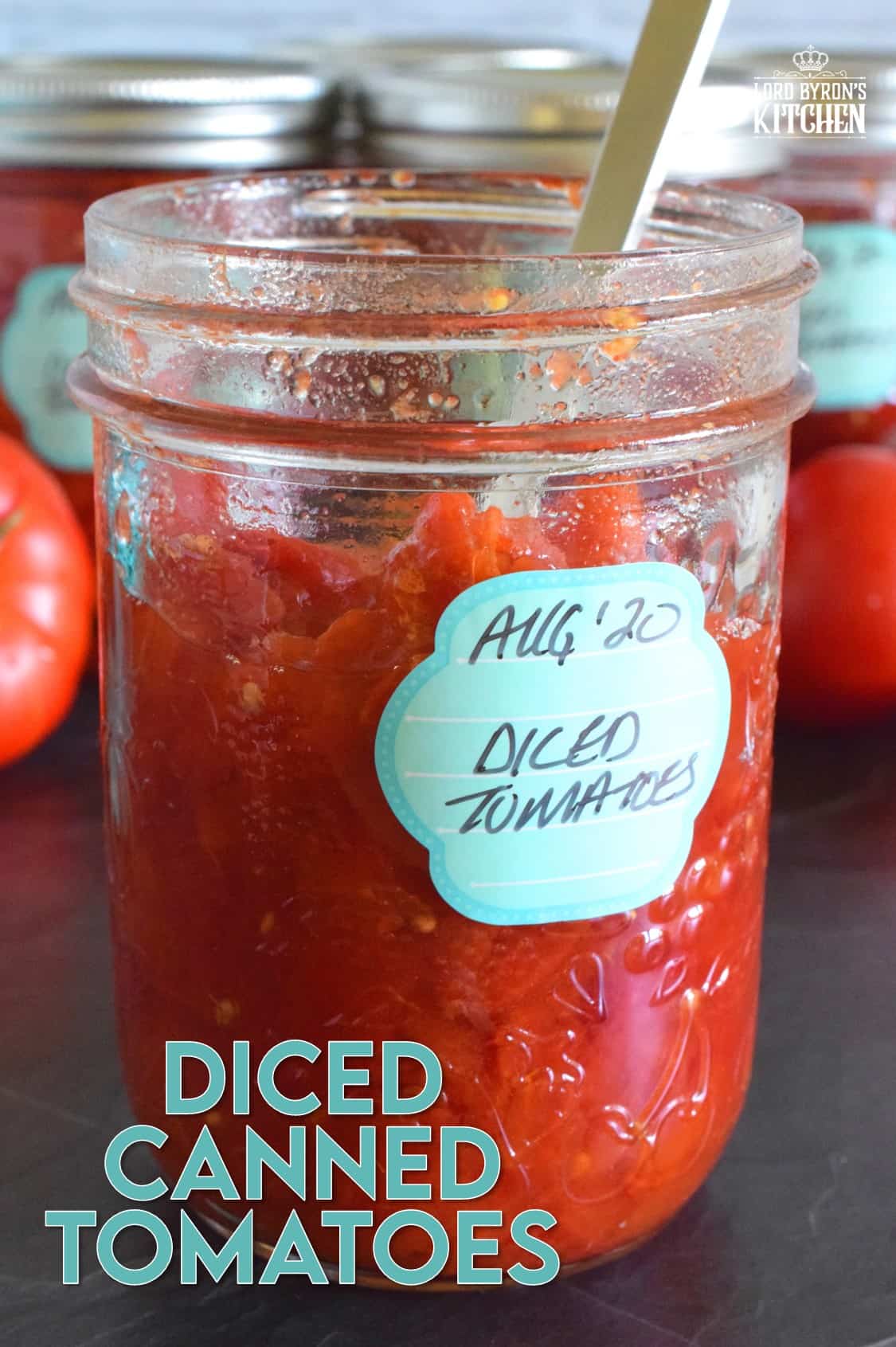
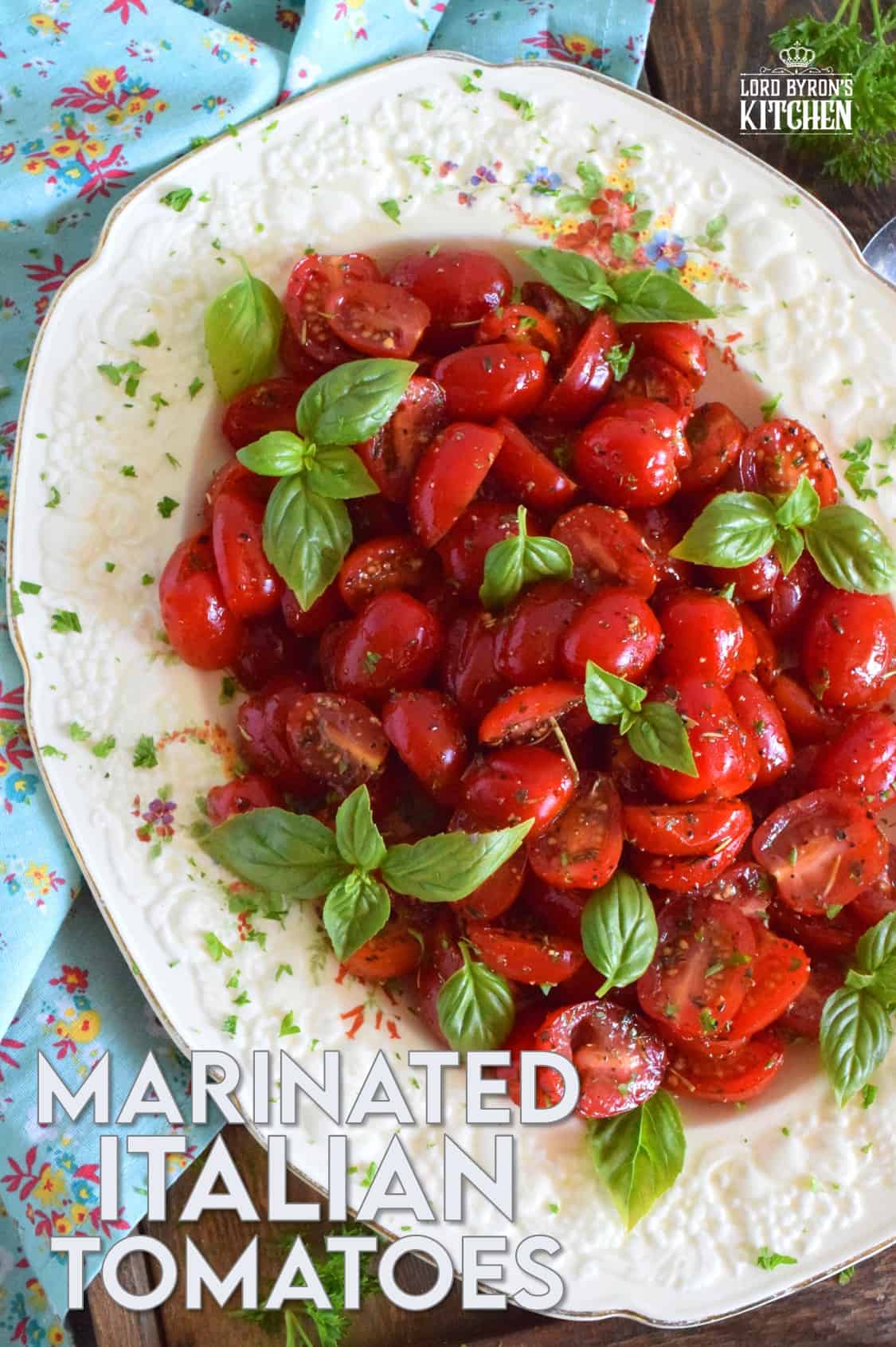
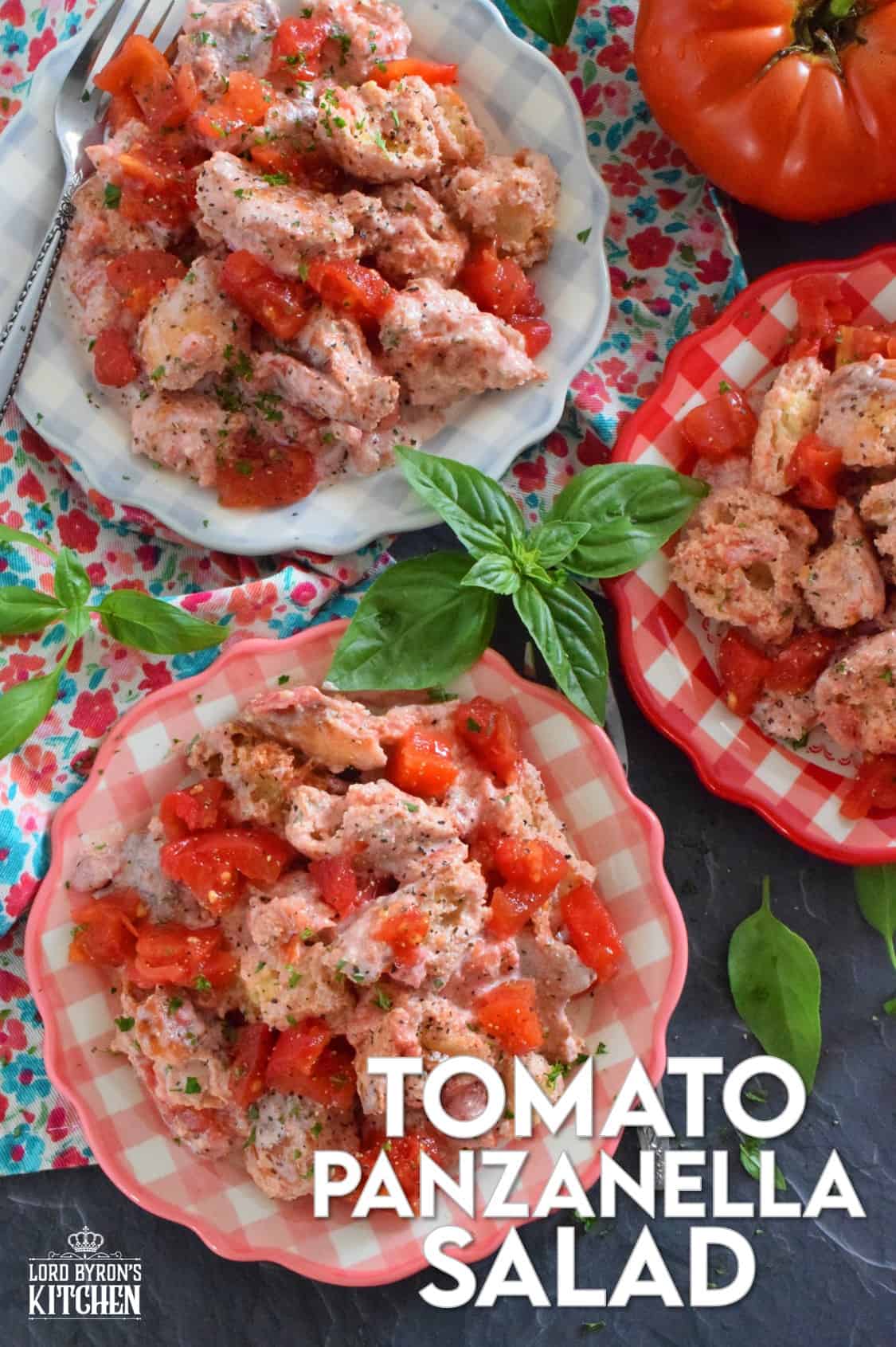

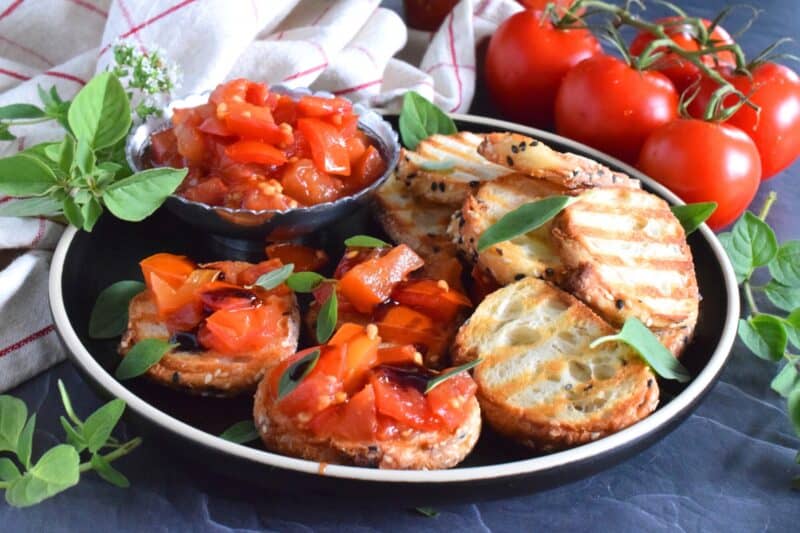
Canned Tomato Bruschetta
Ingredients
- 9 cups tomatoes, cored and chopped
- 1 small red onion, sliced or finely chopped
- 5 cloves garlic, minced
- 1 cup white vinegar
- 1/2 cup water
- 2 tablespoons sugar
- 1 tablespoon dried oregano
- 1 tablespoon dried basil
Instructions
- Add the garlic, vinegar, water, sugar, basil, and oregano to a large saucepan. Over medium heat, bring to a boil. Once boiling, lower the heat to low and simmer for 5 minutes.
- In the meantime, pack the chopped tomatoes and onions into clean mason jars. Once the vinegar mixture has simmered for 5 minutes, ladle it into the jars, covering the tomatoes. Remove any air bubbles and top up the brine, leaving 3/4 of an inch of headspace.
- Place a lid on the jar and waterbath can the jars for 10 minutes. Remove the jars from the canner and allow them to fully cool on a wire cooling rack covered with a clean tea towel for 24 hours. Once cooled, wash and dry the jars. Label and store in a dark, cool pantry.
- When ready to serve, drizzle with a little balsamic vinegar and olive oil. Season with some flaked sea salt.
Notes
Nutrition
Did you make this recipe?
Upload a photo and tag me so that I can see it!


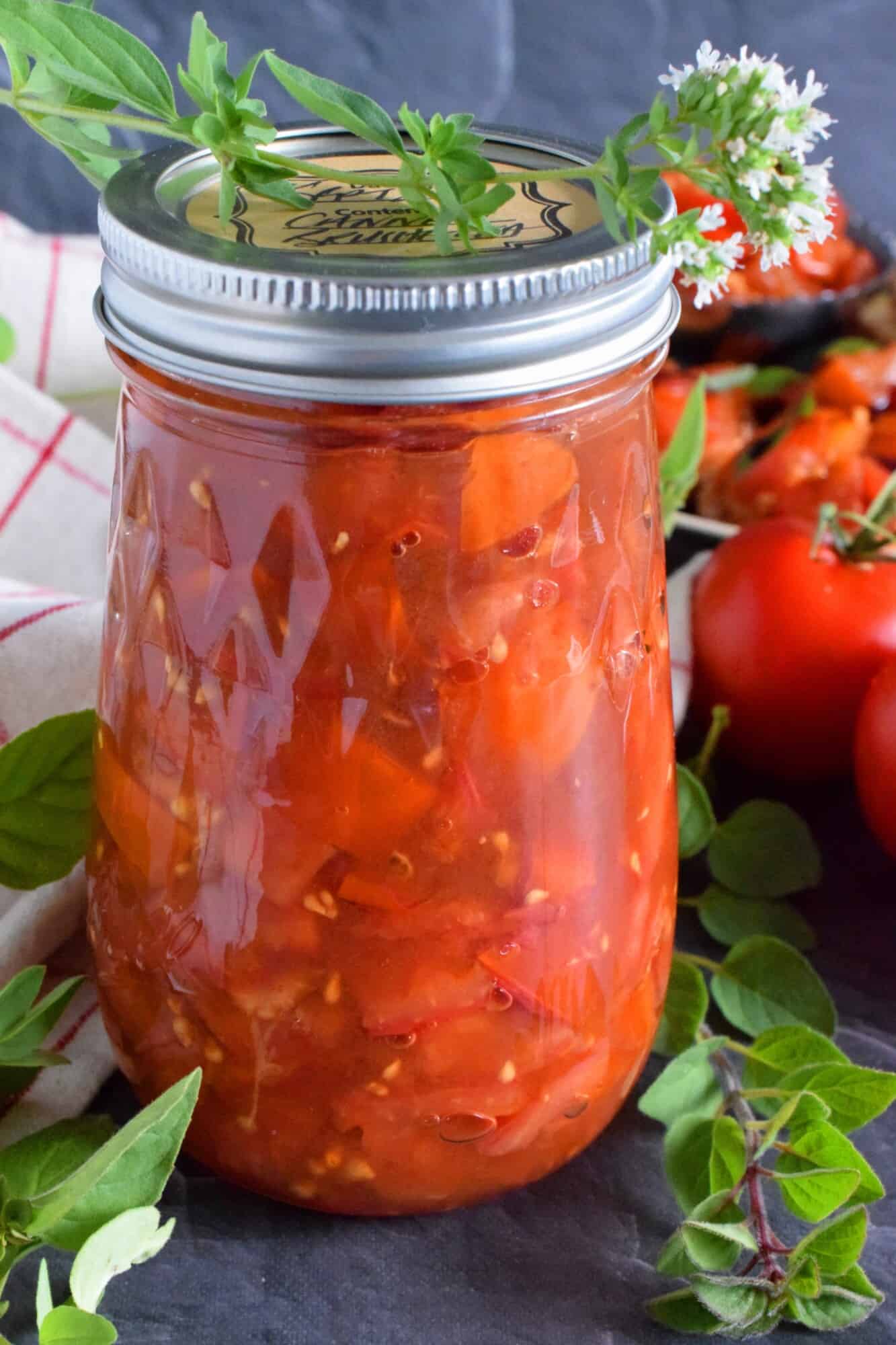



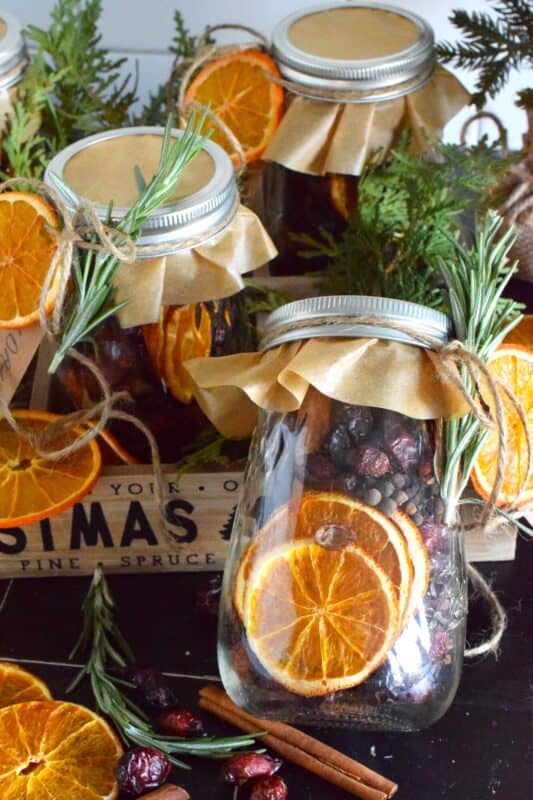








Jamie says
This is such a great idea to stock up and preserve our fresh tomatoes! This looks so delicious and tasty too! A perfect and instant tomato sauce for our pasta dishes! Loved it!
Kim Guzman says
This is brilliant! I look forward to trying it out with my own homegrown tomatoes this season. Nothing like having some tasty remnants of the summer available at my fingertips anytime of the year.
Amy Liu Dong says
I have a bunch of freshly picked tomatoes at home, and this is the perfect recipe to make for them.
Donna Louise Furey says
should the skins be left on the tomatoes?
byronethomas@gmail.com says
Hi Donna – You can certainly take them off if you wish. I didn’t mind them left on, but I wouldn’t mind them taken off either. 🙂
Casey says
Hi the recipe says 1 tbsp oregano 2x. How much is the right amount to add?
byronethomas@gmail.com says
Hi Casey – sorry that was a typing error. It’s one tablespoon of dried oregano and one tablespoon of dried basil. I have updated the recipe card accordingly.
Teresa B says
I have so many cherry tomatoes this year and had used some for bruschetta. Had no idea I could can bruschetta! So glad I found this recipe! Thanks so much!
William Beck says
This recipe looks better than one I have used except, I have gone over everything and couldn’t find the number or size of jars used. Judging by the picture, I’d say 250ml? If it’s there somewhere, please point it out to me. Thanks
byronethomas@gmail.com says
Hi William – those are decorative canning jars, so they are not quite standard, but normally, I use 1/2 pint or 250 ml jars.
Jacki says
I should have read the recipe closer. I mixed it all together from the start and cooked it. Is this going to preserve ok?
byronethomas@gmail.com says
Hi Jacki – it should be okay, although your tomatoes might be a little on the soft side.